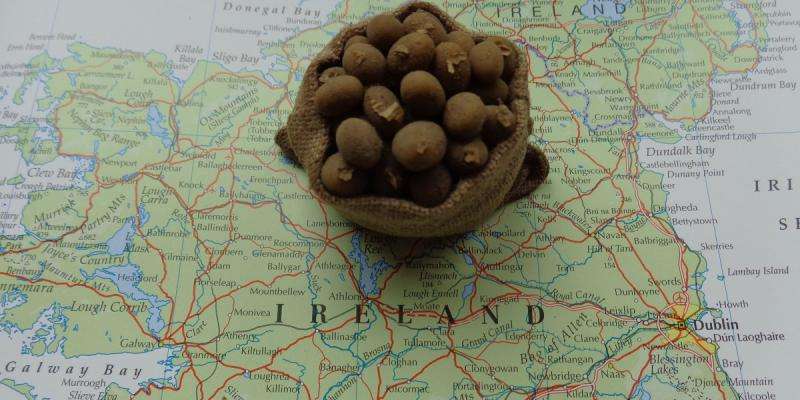A million Irish died during the great famine in the country in the 1840s. The same number emigrated to the USA or other countries. The culprit was potato blight, which still plagues potato farmers today. Credit: Thinkstock
Michael David Martin specializes in analyzing genetic material. He works surrounded by envelopes with plants and pictures of speckled leaves that he is studying at the Norwegian University of Science and Technology's (NTNU) University Museum in the Department of Natural History.
In recent years he has been busy finding out more about blight in plants such as potatoes. The disease has caused both famine and waves of human migration. Martin is focusing primarily on researching the origins of blight itself, but this could also have useful side effects.
"If we can find out where blight originally came from, then we might also be able to find places in Central America or South America with blight resistant potato plants," says Associate Professor Martin.
Genetic analysis can help scientists learn more about this plant disease, which still affects farmers and potato lovers, though not nearly to the same degree as the first blight outbreak in Europe.
In 1845, parts of Europe had become dependent on a plant imported from the New World a few centuries before. The Irish especially based their diet largely on potatoes that grew in the barren soil.
As a result, the consequences were devastating when the potato blight infected European crops. The first known outbreak took place on the east coast of the United States in the early 1840s, and from there the blight spread to Belgium and much of Western Europe.
Among the Irish, one million people died and at least as many Irishmen emigrated to the United States and other places. Tens of thousands of Scots left the Highlands. The rest of Europe had more diverse crops, and were not hit as hard, but Belgium lost around 45,000 people and Prussia over 40,000.
A blight outbreak in a weakened and partly isolated Germany contributed to 700,000 people dying of starvation during World War I. The disease is still wreaking havoc.
Most farmers are familiar with blight. Researchers calls the disease-causing organism Phytophthora infestans, where Phytophthora simply means "plant killer" and infestans can hardly mean anything nice.
Blight is often described as a fungus, but the name is misleading as it belongs to the scientific class of plants called Oomycetes, or water moulds, a group of a fungus-like microorganisms that have historically been lumped with the Kingdom Fungi, but which actually form a distinct phylogenetic lineage.
The good news is that the blight variant that led to the deaths of so many Europeans in the 1840s may not exist anymore. The bad news is that today's varieties are far worse than that earlier one, which probably would have done far less harm today.
Europeans learned to fight blight by introducing new potato plants from the New World that had greater resistance to the disease. The outbreak actually led to a beginning of selective breeding in order to resist future disease outbreaks.
An attack on a potato store in Ireland during the great famine caused by potato blight. Credit: Thinkstock
But blight continues to infect potato crops and their closely related tomato cousins as the disease has evolved apace of the fight to eradicate it.
Apparently, we are part of a perpetual race, where breeders and scientists develop new potato plants that are resistant to blight, and where blight, through natural selection, continually develops new varieties to also wipe out the new potato plants. But there is hope—if we can learn more about the disease.
Scientists still argue about where blight started.
"Most scientists believe blight evolved in the Mexican highlands. Others believe it came from the Andes, in the same area that potatoes originated," says Martin.
The question of where blight actually originated may sound like something that only botanists would be interested in. But it is important to find the answer, for farmers and potato lovers alike.
If researchers can find out where blight came from originally, they can also look at wild potato plants in the area. Those plants would have needed to develop (or evolve) resistance to disease over many generations to avoid extinction.
A few years ago some scientists believed they could confirm that blight had originated in Mexico. But it wasn't that simple.
Martin analysed over 70 different historical samples of Phytophthora infestans and of another species called Phytophthora andina with his colleagues at the University of Copenhagen.
The second species was originally a cross between P. infestans and a third species that no one has yet identified with certainty. P. andina, as the name suggests, exists only in the Andes.
"We found four basic gene sequences in P. andina that are a close match to the variant that caused the famine in the 1840s. Our analyses also show that P. andina and the historical variant of P. infestans split into two distinct groups before the modern Mexican varieties developed," says Martin.
In layman's terms, this means that the disease may have originated in the Andes earlier than variants of the disease evolved in Mexico.
Does that give us a definitive blueprint? No, not really, but it does cast doubt on the idea that Mexico is the site where the disease originated. It also confirms that the evolutionary history of blight is very complex. We need to know more.
And although Martin recently completed his time in Copenhagen, he is continuing his research on blight.
More information: Michael D. Martin et al. Genomic Characterization of a South AmericanHybrid Mandates Reassessment of the Geographic Origins of, Molecular Biology and Evolution (2016). DOI: 10.1093/molbev/msv241
Journal information: Molecular Biology and Evolution
Provided by Norwegian University of Science and Technology
























